Paper Menu >>
Journal Menu >>
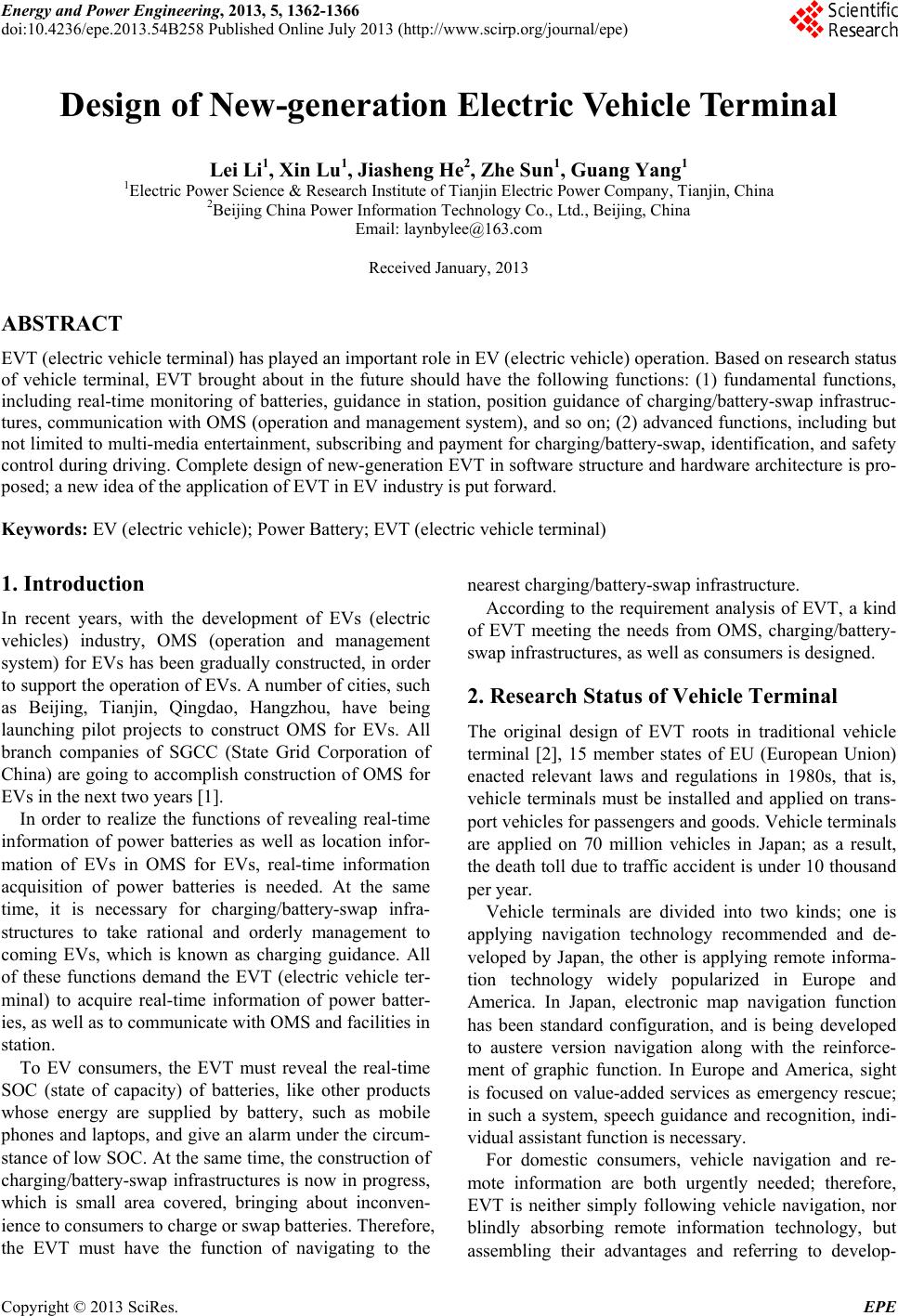 Energy and Power Engineering, 2013, 5, 1362-1366 doi:10.4236/epe.2013.54B258 Published Online July 2013 (http://www.scirp.org/journal/epe) Design of New-generation Electric Vehicle Terminal Lei Li1, Xin Lu1, Jiasheng He2, Zhe Sun1, Guang Yang1 1Electric Power Science & Research Institute of Tianjin Electric Power Company, Tianjin, China 2Beijing China Power Information Technology Co., Ltd., Beijing, China Email: laynbylee@163.com Received January, 2013 ABSTRACT EVT (electric vehicle terminal) has played an important role in EV (electric vehicle) operation. Based on research status of vehicle terminal, EVT brought about in the future should have the following functions: (1) fundamental functions, including real-time monitoring of batteries, guidance in station, position guidance of charging/battery-swap infrastruc- tures, communication with OMS (operation and management system), and so on; (2) advanced functions, including but not limited to multi-media entertainment, subscribing and payment for charging/battery-swap, iden tification, and safety control during driving. Complete design of new-generation EVT in software structure and hardware architecture is pro- posed; a new idea of the application of EVT in EV industry is put forward. Keywords: EV (electric vehicle); Power Battery; EVT (electric vehicle terminal) 1. Introduction In recent years, with the development of EVs (electric vehicles) industry, OMS (operation and management system) for EVs has been gradually constructed, in order to support th e operation of EVs. A number of cities, su ch as Beijing, Tianjin, Qingdao, Hangzhou, have being launching pilot projects to construct OMS for EVs. All branch companies of SGCC (State Grid Corporation of China) are going to accomplish construction of OMS for EVs in the next two years [1]. In order to realize the functions of revealing real-time information of power batteries as well as location infor- mation of EVs in OMS for EVs, real-time information acquisition of power batteries is needed. At the same time, it is necessary for charging/battery-swap infra- structures to take rational and orderly management to coming EVs, which is known as charging guidance. All of these functions demand the EVT (electric vehicle ter- minal) to acquire real-time information of power batter- ies, as well as to communicate with OMS and facilities in station. To EV consumers, the EVT must reveal the real-time SOC (state of capacity) of batteries, like other products whose energy are supplied by battery, such as mobile phones and laptops, and give an alarm under the circum- stance of low SOC. At the same time, the construction of charging/battery-swap infrastructures is now in progress, which is small area covered, bringing about inconven- ience to consumers to charge or swap batteries. Therefore, the EVT must have the function of navigating to the nearest charging/battery-swap infrastructure. According to the requirement analysis of EVT, a kind of EVT meeting the needs from OMS, charging/battery- swap infrastructures, as well as consumers is designed. 2. Research Status of Vehicle Terminal The original design of EVT roots in traditional vehicle terminal [2], 15 member states of EU (European Union) enacted relevant laws and regulations in 1980s, that is, vehicle terminals must be installed and applied on trans- port vehicles for passengers and goods. Vehicle terminals are applied on 70 million vehicles in Japan; as a result, the death toll due to traffic accident is under 10 thousand per year. Vehicle terminals are divided into two kinds; one is applying navigation technology recommended and de- veloped by Japan, the other is applying remote informa- tion technology widely popularized in Europe and America. In Japan, electronic map navigation function has been standard configuration, and is being developed to austere version navigation along with the reinforce- ment of graphic function. In Europe and America, sight is focused on value-added services as emergency rescue; in such a system, speech guidance and recognition, indi- vidual assistant function is necessary. For domestic consumers, vehicle navigation and re- mote information are both urgently needed; therefore, EVT is neither simply following vehicle navigation, nor blindly absorbing remote information technology, but assembling their advantages and referring to develop- Copyright © 2013 SciRes. EPE 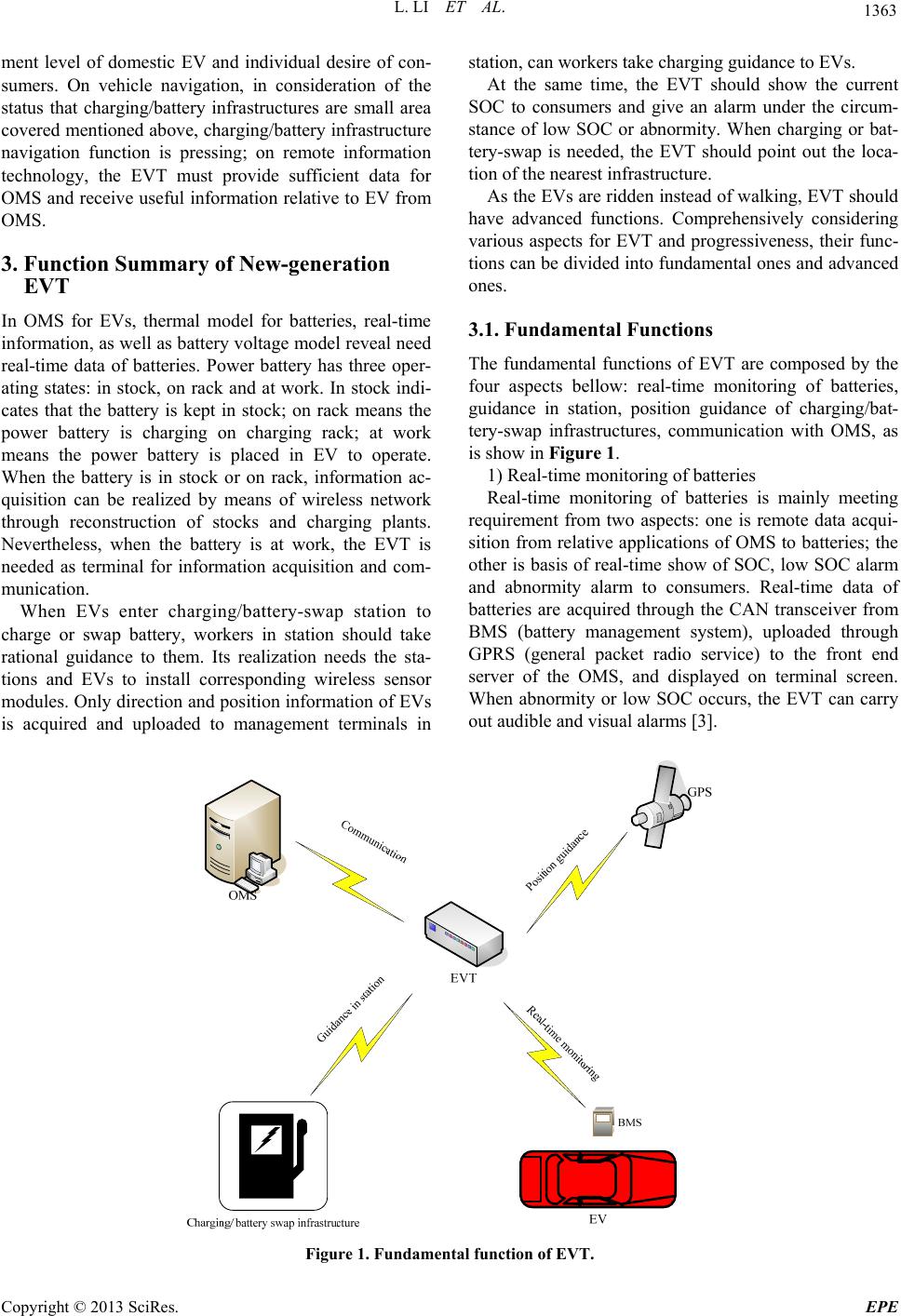 L. LI ET AL. 1363 ment level of domestic EV and individual desire of con- sumers. On vehicle navigation, in consideration of the status that charging/battery infrastructures are small area covered mentioned above, charging/battery infrastructure navigation function is pressing; on remote information technology, the EVT must provide sufficient data for OMS and receive useful information relative to EV fro m OMS. 3. Function Summary of New-generation EVT In OMS for EVs, thermal model for batteries, real-time information, as well as battery v oltage model reveal need real-time data of batteries. Power battery has three oper- ating states: in stock, on rack and at work. In stock indi- cates that the battery is kept in stock; on rack means the power battery is charging on charging rack; at work means the power battery is placed in EV to operate. When the battery is in stock or on rack, information ac- quisition can be realized by means of wireless network through reconstruction of stocks and charging plants. Nevertheless, when the battery is at work, the EVT is needed as terminal for information acquisition and com- munication. When EVs enter charging/battery-swap station to charge or swap battery, workers in station should take rational guidance to them. Its realization needs the sta- tions and EVs to install corresponding wireless sensor modules. Only direction and position information of EVs is acquired and uploaded to management terminals in station, can workers take charging guidance to EVs. At the same time, the EVT should show the current SOC to consumers and give an alarm under the circum- stance of low SOC or abnormity. When charging or bat- tery-swap is needed, the EVT should point out the loca- tion of the nearest infrastructure. As the EV s are ridd en instead of walking, EV T should have advanced functions. Comprehensively considering various aspects for EVT and progressiveness, their func- tions can be divided into fundamental ones and advanced ones. 3.1. Fundamental Functions The fundamental functions of EVT are composed by the four aspects bellow: real-time monitoring of batteries, guidance in station, position guidance of charging/bat- tery-swap infrastructures, communication with OMS, as is show in Figure 1. 1) Real-time monitoring of batteries Real-time monitoring of batteries is mainly meeting requirement from two aspects: one is remote data acqui- sition from relative applications of OMS to batteries; the other is basis of real-time show of SOC, low SOC alarm and abnormity alarm to consumers. Real-time data of batteries are acquired through the CAN transceiver from BMS (battery management system), uploaded through GPRS (general packet radio service) to the front end server of the OMS, and displayed on terminal screen. When abnormity or low SOC occurs, the EVT can carry out audible and visual alarms [3]. Figure 1. Fundamental function of EVT. Copyright © 2013 SciRes. EPE 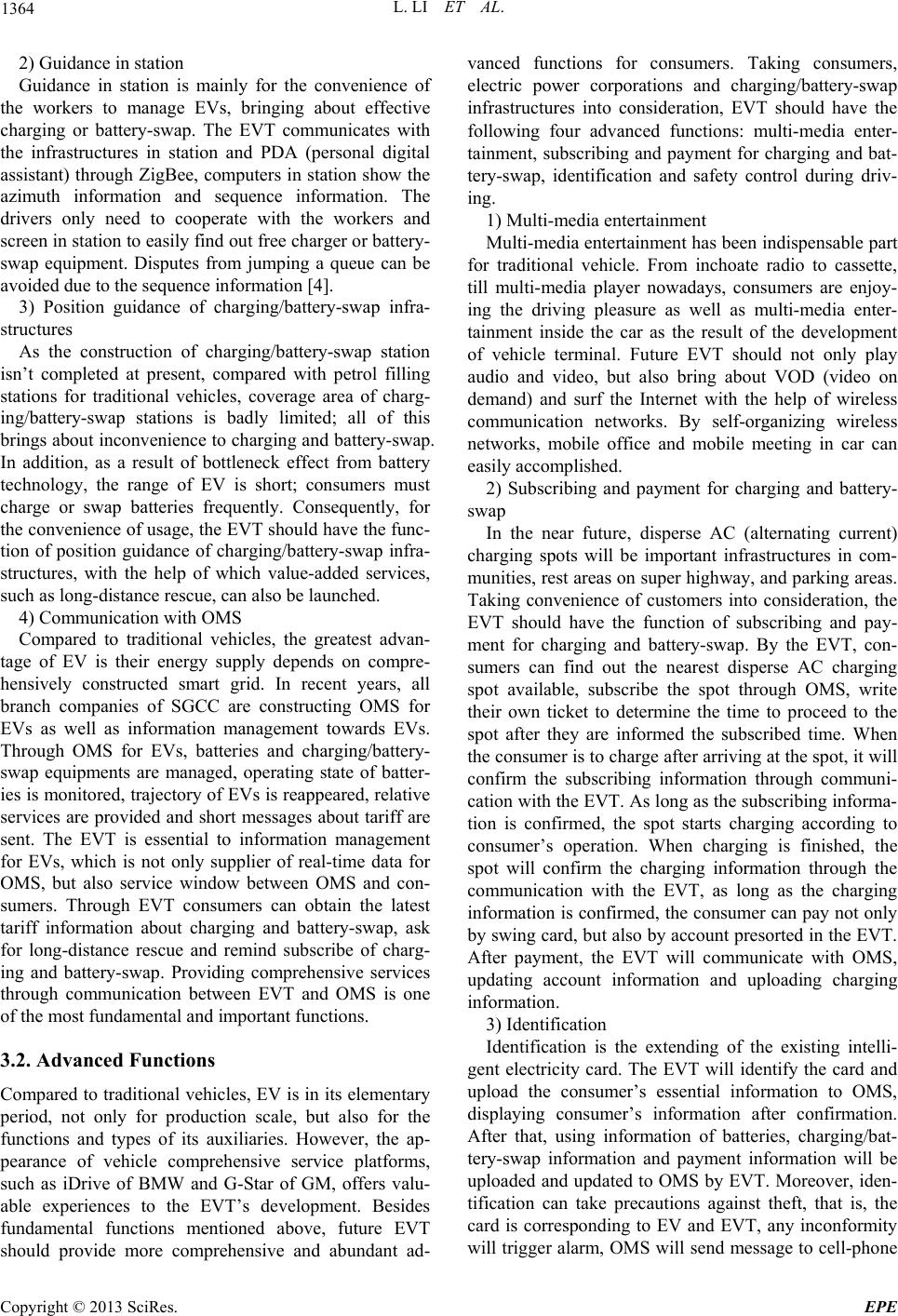 L. LI ET AL. 1364 2) Guidance in station Guidance in station is mainly for the convenience of the workers to manage EVs, bringing about effective charging or battery-swap. The EVT communicates with the infrastructures in station and PDA (personal digital assistant) through ZigBee, computers in station show the azimuth information and sequence information. The drivers only need to cooperate with the workers and screen in station to easily find out free charger or battery- swap equipment. Disputes from jumping a queue can be avoided due to the sequence information [4]. 3) Position guidance of charging/battery-swap infra- structures As the construction of charging/battery-swap station isn’t completed at present, compared with petrol filling stations for traditional vehicles, coverage area of charg- ing/battery-swap stations is badly limited; all of this brings about inconvenience to charging and battery-swap. In addition, as a result of bottleneck effect from battery technology, the range of EV is short; consumers must charge or swap batteries frequently. Consequently, for the convenience of usage, the EVT should have the func- tion of position guidance of charging/battery-swap infra- structures, with the help of which value-added services, such as long-distance rescue, can also be launched. 4) Comm uni cat i on wi t h OM S Compared to traditional vehicles, the greatest advan- tage of EV is their energy supply depends on compre- hensively constructed smart grid. In recent years, all branch companies of SGCC are constructing OMS for EVs as well as information management towards EVs. Through OMS for EVs, batteries and charging/battery- swap equipments are managed, operating state of batter- ies is monitored, trajectory of EVs is reappeared, relative services are provided and short messages about tariff are sent. The EVT is essential to information management for EVs, which is not only supplier of real-time data for OMS, but also service window between OMS and con- sumers. Through EVT consumers can obtain the latest tariff information about charging and battery-swap, ask for long-distance rescue and remind subscribe of charg- ing and battery-swap. Providing comprehensive services through communication between EVT and OMS is one of the most fundamental and important functions. 3.2. Advanced Functions Compared to traditional vehicles, EV is in its elementary period, not only for production scale, but also for the functions and types of its auxiliaries. However, the ap- pearance of vehicle comprehensive service platforms, such as iDrive of BMW and G-Star of GM, offers valu- able experiences to the EVT’s development. Besides fundamental functions mentioned above, future EVT should provide more comprehensive and abundant ad- vanced functions for consumers. Taking consumers, electric power corporations and charging/battery-swap infrastructures into consideration, EVT should have the following four advanced functions: multi-media enter- tainment, subscribing and payment for charging and bat- tery-swap, identification and safety control during driv- ing. 1) Multi-media entertainment Multi-media entertainment has b een indispensable pa rt for traditional vehicle. From inchoate radio to cassette, till multi-media player nowadays, consumers are enjoy- ing the driving pleasure as well as multi-media enter- tainment inside the car as the result of the development of vehicle terminal. Future EVT should not only play audio and video, but also bring about VOD (video on demand) and surf the Internet with the help of wireless communication networks. By self-organizing wireless networks, mobile office and mobile meeting in car can easily accomplished. 2) Subscribing and payment for charging and battery- swap In the near future, disperse AC (alternating current) charging spots will be important infrastructures in com- munities, rest areas on super highway, and parking areas. Taking convenience of customers into consideration, the EVT should have the function of subscribing and pay- ment for charging and battery-swap. By the EVT, con- sumers can find out the nearest disperse AC charging spot available, subscribe the spot through OMS, write their own ticket to determine the time to proceed to the spot after they are informed the subscribed time. When the consumer is to charge after arriving at the spot, it will confirm the subscribing information through communi- cation with the EVT. As long as the subscribing informa- tion is confirmed, the spot starts charging according to consumer’s operation. When charging is finished, the spot will confirm the charging information through the communication with the EVT, as long as the charging information is confirmed, the consu mer can pay not only by swing card, but also by account presorted in the EVT. After payment, the EVT will communicate with OMS, updating account information and uploading charging information. 3) Identification Identification is the extending of the existing intelli- gent electricity card. The EVT will identify the card and upload the consumer’s essential information to OMS, displaying consumer’s information after confirmation. After that, using information of batteries, charging/bat- tery-swap information and payment information will be uploaded and updated to OMS by EVT. Moreover, iden- tification can take precautions against theft, that is, the card is corresponding to EV and EVT, any inconformity will trigger alarm, OMS will send message to cell-phone Copyright © 2013 SciRes. EPE 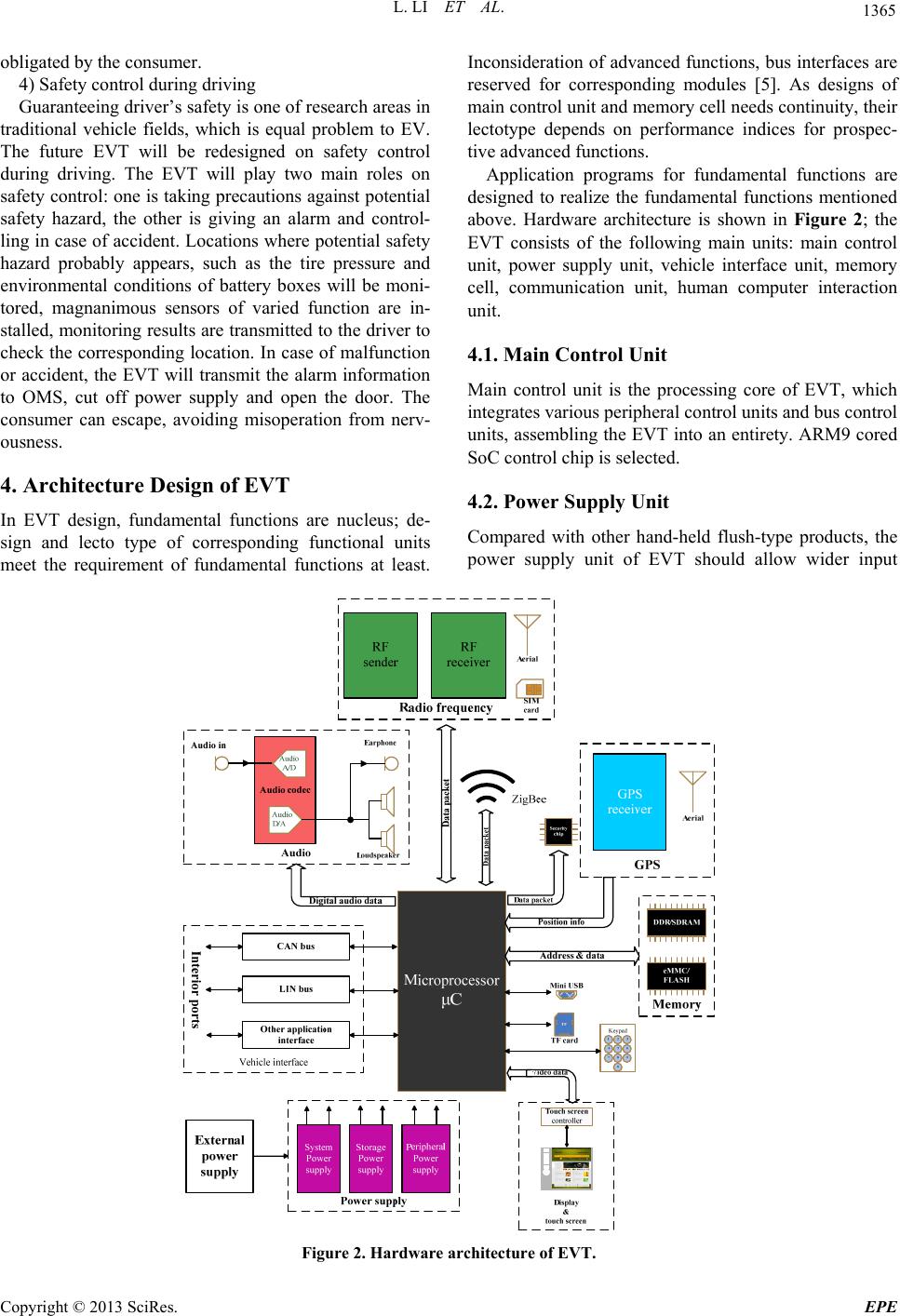 L. LI ET AL. 1365 obligated by the consumer. 4) Safety control during driving Guaranteeing driver’s safety is one of research areas in traditional vehicle fields, which is equal problem to EV. The future EVT will be redesigned on safety control during driving. The EVT will play two main roles on safety control: one is taking precautions against potential safety hazard, the other is giving an alarm and control- ling in case of accident. Locations where potential safety hazard probably appears, such as the tire pressure and environmental conditions of battery boxes will be moni- tored, magnanimous sensors of varied function are in- stalled, monitoring results ar e transmitted to the driver to check the corresponding location. In case of malfunction or accident, the EVT will transmit the alarm information to OMS, cut off power supply and open the door. The consumer can escape, avoiding misoperation from nerv- ousness. 4. Architecture Design of EVT In EVT design, fundamental functions are nucleus; de- sign and lecto type of corresponding functional units meet the requirement of fundamental functions at least. Inconsideration of advanced functions, bus interfaces are reserved for corresponding modules [5]. As designs of main control unit an d memory cell needs con tinu ity, their lectotype depends on performance indices for prospec- tive advanced functions. Application programs for fundamental functions are designed to realize the fundamental functions mentioned above. Hardware architecture is shown in Figure 2; the EVT consists of the following main units: main control unit, power supply unit, vehicle interface unit, memory cell, communication unit, human computer interaction unit. 4.1. Main Control Unit Main control unit is the processing core of EVT, which integrates various per i pheral cont ro l units and bus con t rol units, assembling the EVT into an entirety. ARM9 cored SoC control chip is selected. 4.2. Power Supply Unit Compared with other hand-held flush-type products, the power supply unit of EVT should allow wider input Figure 2. Hardware architecture of EVT. Copyright © 2013 SciRes. EPE 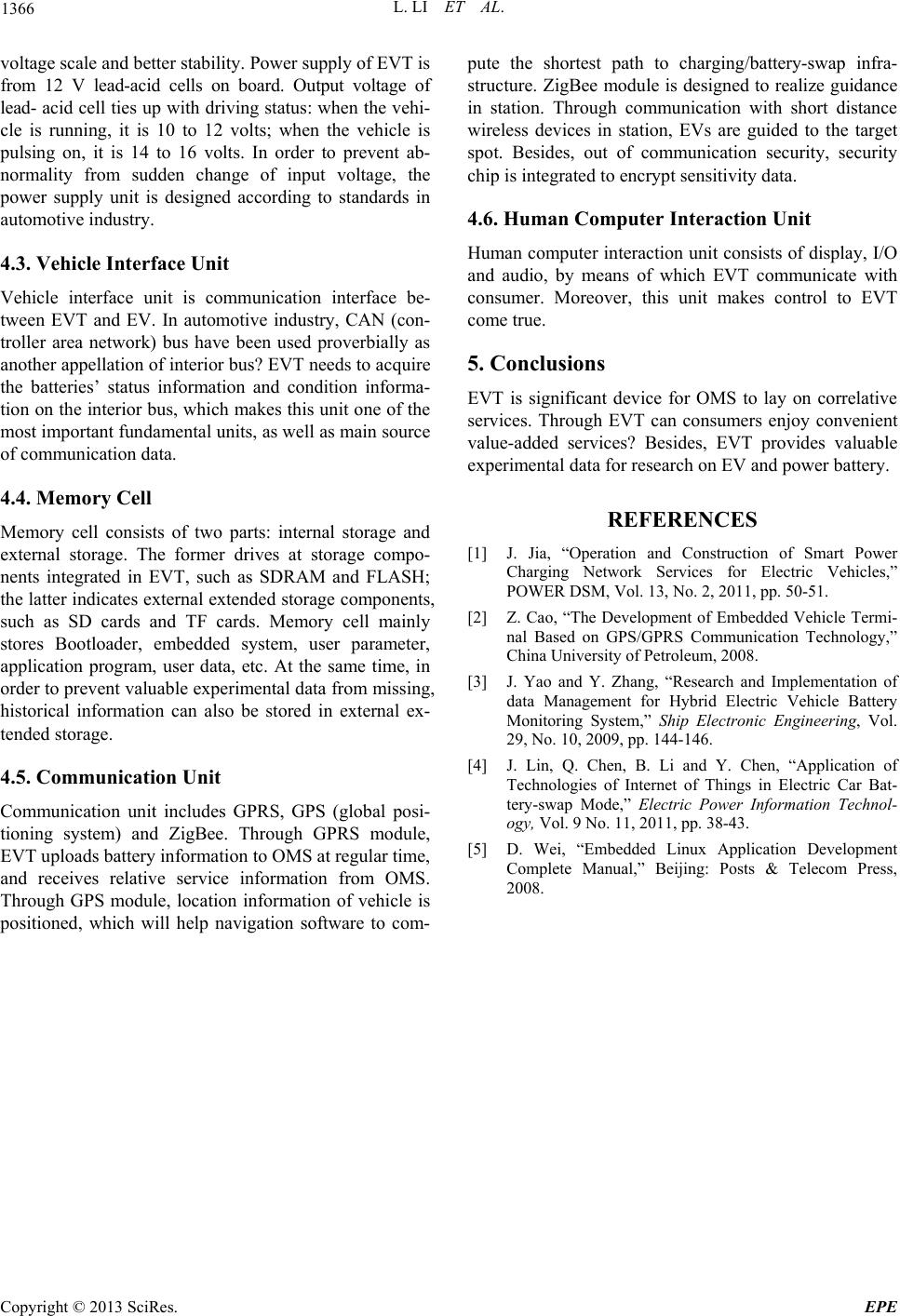 L. LI ET AL. 1366 voltage scale and better stability. Power supply of EVT is from 12 V lead-acid cells on board. Output voltage of lead- acid cell ties up with driving status: when the vehi- cle is running, it is 10 to 12 volts; when the vehicle is pulsing on, it is 14 to 16 volts. In order to prevent ab- normality from sudden change of input voltage, the power supply unit is designed according to standards in automotive industry. 4.3. Vehicle Interface Unit Vehicle interface unit is communication interface be- tween EVT and EV. In automotive industry, CAN (con- troller area network) bus have been used proverbially as another appellation of interior bus? EVT needs to acquire the batteries’ status information and condition informa- tion on the interior bus, which makes this unit one of the most important fundamental units, as well as main source of communication data. 4.4. Memory Cell Memory cell consists of two parts: internal storage and external storage. The former drives at storage compo- nents integrated in EVT, such as SDRAM and FLASH; the latter indicates external extended storage components, such as SD cards and TF cards. Memory cell mainly stores Bootloader, embedded system, user parameter, application program, user data, etc. At the same time, in order to prevent valuable experimental data from missing, historical information can also be stored in external ex- tended storage. 4.5. Communication Unit Communication unit includes GPRS, GPS (global posi- tioning system) and ZigBee. Through GPRS module, EVT uploads battery information to OMS at regular time, and receives relative service information from OMS. Through GPS module, location information of vehicle is positioned, which will help navigation software to com- pute the shortest path to charging/battery-swap infra- structure. ZigBee module is designed to realize guidance in station. Through communication with short distance wireless devices in station, EVs are guided to the target spot. Besides, out of communication security, security chip is integrated to encrypt sensitivity data. 4.6. Human Computer Interaction Unit Human computer interaction unit cons ists of display, I/O and audio, by means of which EVT communicate with consumer. Moreover, this unit makes control to EVT come true. 5. Conclusions EVT is significant device for OMS to lay on correlative services. Through EVT can consumers enjoy convenient value-added services? Besides, EVT provides valuable experimental data for research on EV and power battery. REFERENCES [1] J. Jia, “Operation and Construction of Smart Power Charging Network Services for Electric Vehicles,” POWER DSM, Vol. 13, No. 2, 2011, pp. 50-51. [2] Z. Cao, “The Development of Embedded Vehicle Termi- nal Based on GPS/GPRS Communication Technology,” China University of Petroleum, 2008. [3] J. Yao and Y. Zhang, “Research and Implementation of data Management for Hybrid Electric Vehicle Battery Monitoring System,” Ship Electronic Engineering, Vol. 29, No. 10, 2009, pp. 144-146. [4] J. Lin, Q. Chen, B. Li and Y. Chen, “Application of Technologies of Internet of Things in Electric Car Bat- tery-swap Mode,” Electric Power Information Technol- ogy, Vol. 9 No. 11, 2011, pp. 38-43. [5] D. Wei, “Embedded Linux Application Development Complete Manual,” Beijing: Posts & Telecom Press, 2008. Copyright © 2013 SciRes. EPE |

